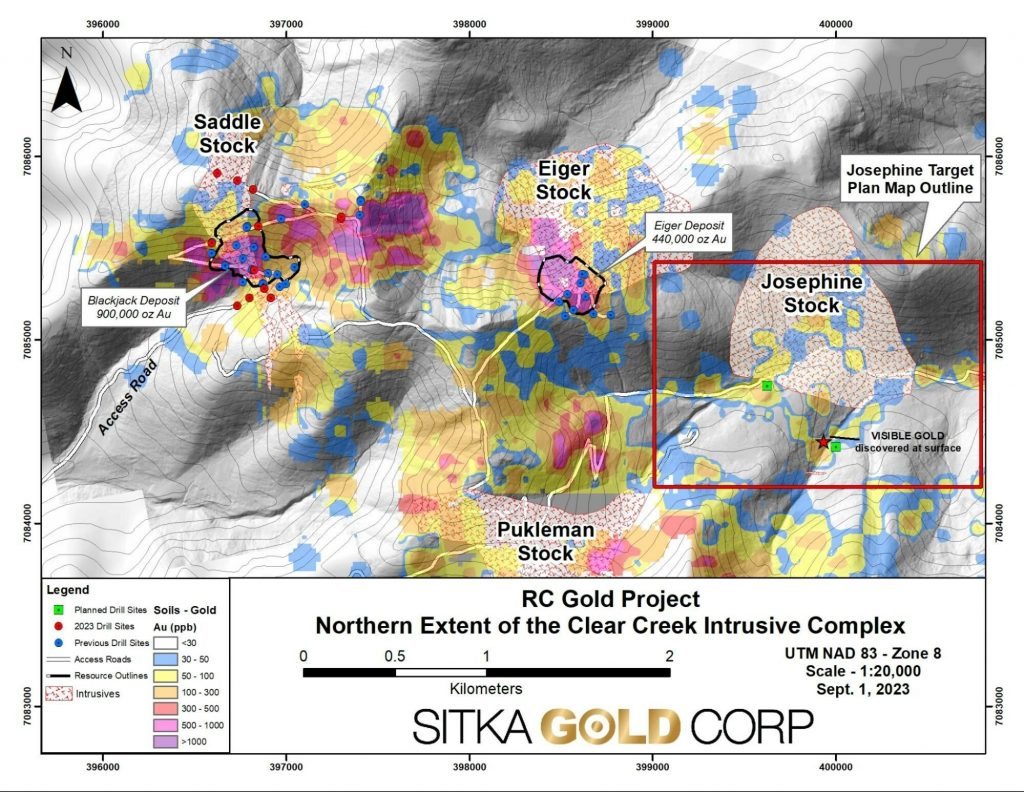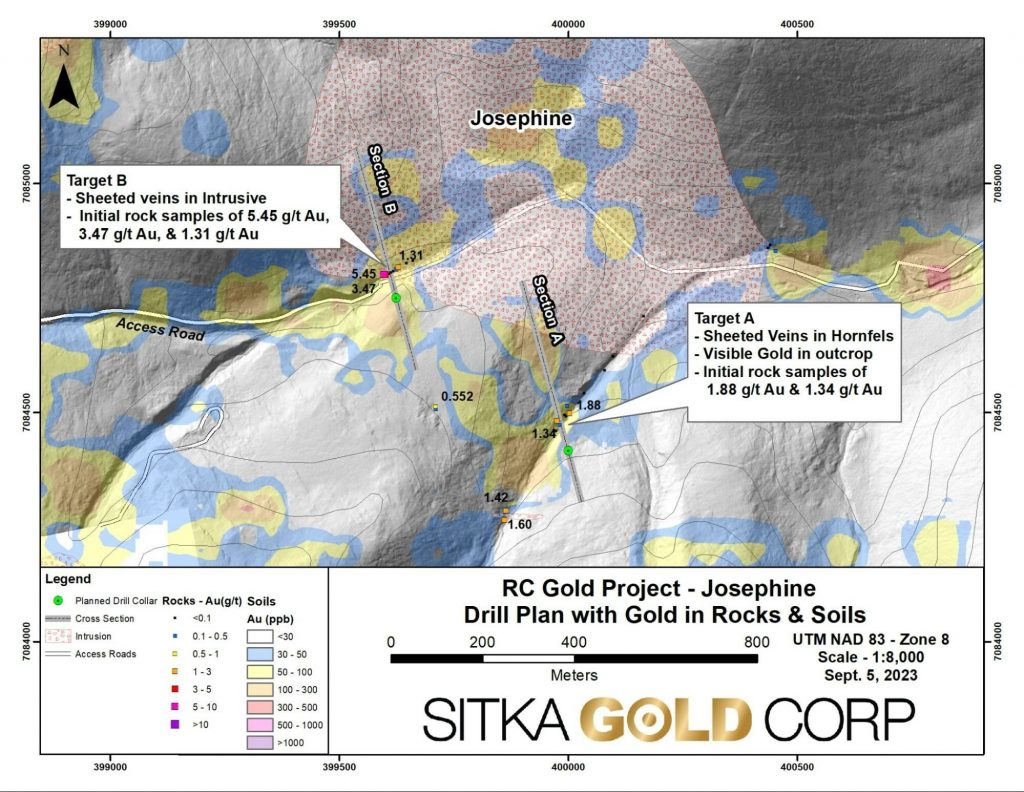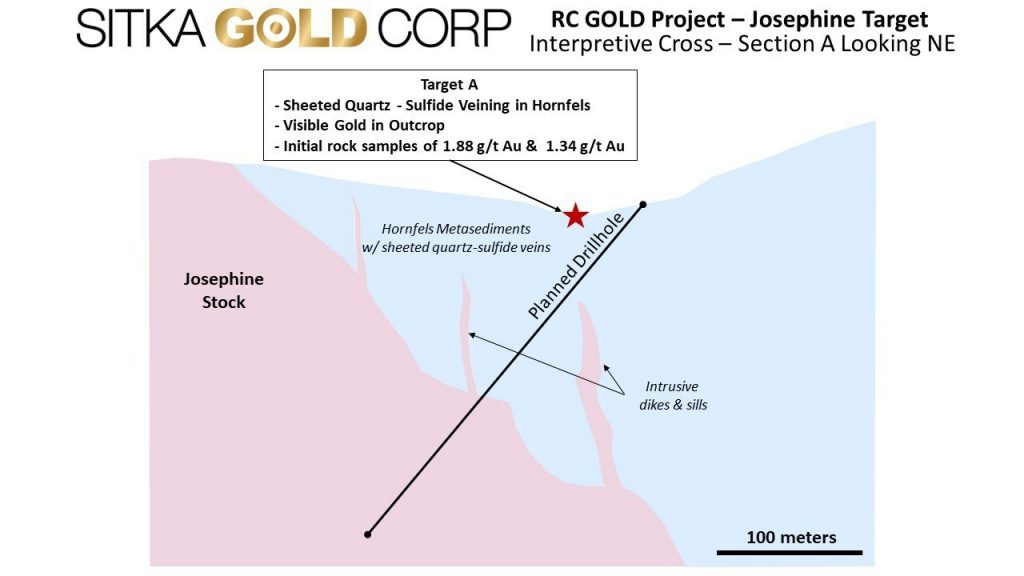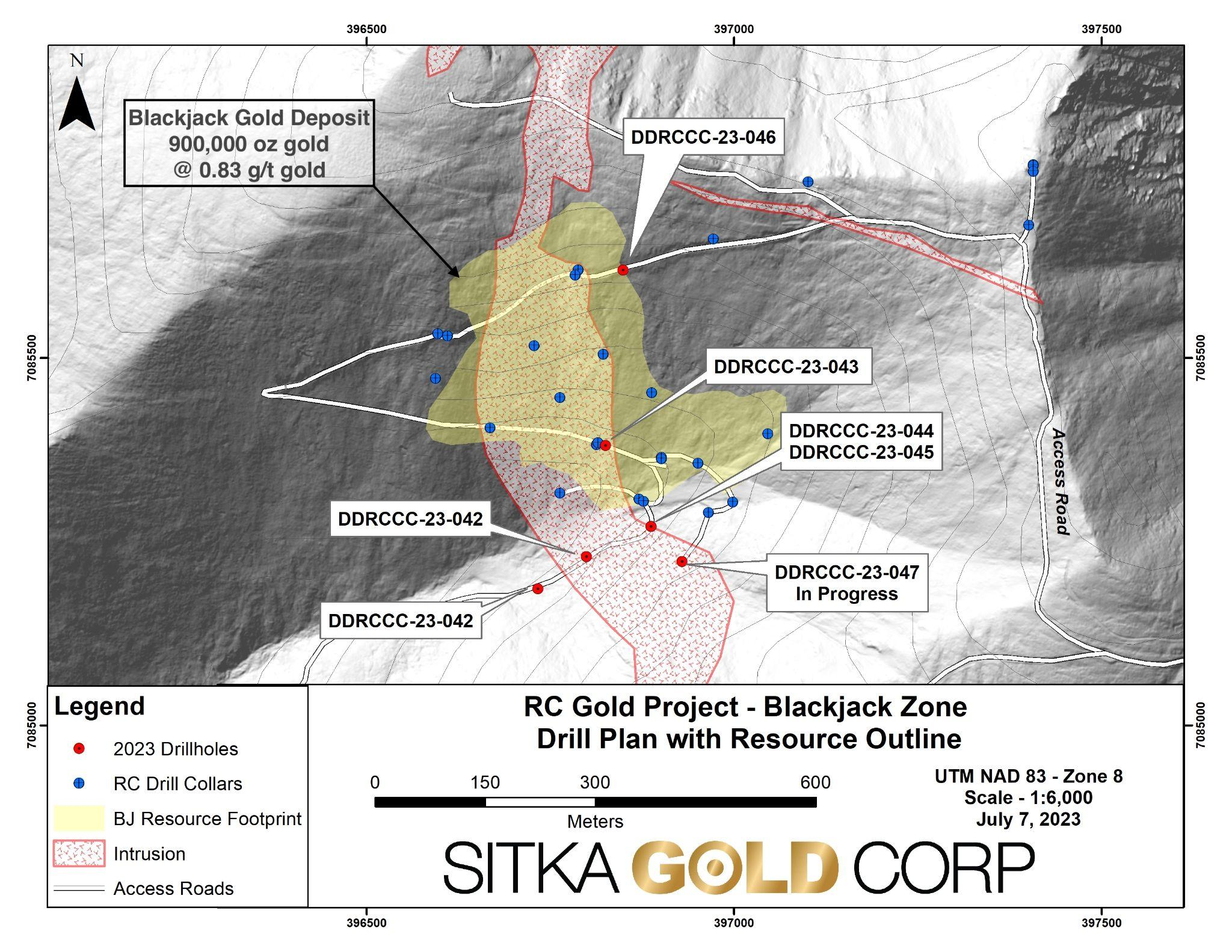
Sitka Gold (CSE:SIG) has commenced the maiden diamond drill testing of the Josephine intrusion, situated in the northern section of the Clear Creek Intrusive Complex (CCIC) on its RC Gold Project in Yukon’s Tombstone Gold Belt, roughly 100 kilometres east of Dawson City. This road-accessible project, spanning 376 square kilometres, is currently experiencing a diamond drilling exercise of up to 10,000 metres. Earlier this year, the project was noted to have an Initial Mineral Resource Estimate of approximately 1,340,000 ounces of gold with a grade of 0.68 g/t, beginning at the surface.
Cor Coe, Director and CEO of Sitka Gold, commented in a press release: “We are excited to be conducting the first ever diamond drilling of the Josephine intrusion, one of the six intrusions located in the Clear Creek Intrusive Complex (See Figure 1). The discovery of visible gold this summer in the altered rocks adjacent to the intrusion during geological mapping and subsequent prospecting, which identified gold-bearing sheeted veins both within the intrusion and in the adjacent altered rocks, highlights the potential of the Josephine intrusion. The intrusion is not well exposed at surface so we look forward to getting an initial look using the drill bit at the potential of the Josephine to be the third intrusion on the project to host a gold deposit.

From the Josephine target, results for 30 out of 86 surface rock samples have been collected. The gold values in these samples varied between 0.003 g/t and 5.45 g/t. Notably, seven samples showed results surpassing 1.0 g/t Au, while thirteen samples displayed values exceeding 0.10 g/t Au.
The company has outlined plans for two drill holes to examine two targets, located roughly 500 metres apart, on the southern boundary of the Josephine intrusion. To facilitate the drilling tests for these specific targets, a second diamond drill rig has been dispatched to the RC Gold Project.
The first of these, dubbed Target A, is the site where geological surveys and prospecting previously identified visible gold at the surface. The prospected area revealed altered and mineralized metasedimentary rocks stretching about 500 metres south of the intrusion. This initial drill aims to evaluate the most profoundly altered rocks spanning an area of around 220 metres. These rocks are marked by abundant veining that contains arsenopyrite-pyrite and occasionally bismuthinite mineralization. The drill is also expected to encounter the obscured intrusive contact deeper down.
Meanwhile, Target B is positioned roughly 500 metres northwest of Target A. Here, an exposure of the Josephine intrusion was found alongside altered metasedimentary rocks in a creek base. Both these rocks and the intrusion itself were richly mineralized with veins comprised of arsenopyrite-pyrite, with occasional bismuthinite content. This preliminary drill is set to assess the Josephine intrusion at its southern contact.
To date, within its 2023 diamond drill venture at RC Gold, Sitka Gold has wrapped up 14 drill holes, amounting to nearly 6,000 metres. Reports for the other 9 drill holes, completed so far, are anticipated to be made public once received and organized.

Highlights from surface exploration:
- Target A
- Sheeted veins in altered metasedimentary rocks adjacent to intrusion returned values of 1.88 and 1.34 g/t gold
- Visible gold in outcrop
- Target B
- Sheeted veins in intrusive returned values of 5.45, 3.47 and 1.31 g/t gold
Table 2: RC Gold Inferred Mineral Resource Estimate
|
COG g/t Au |
Blackjack Zone |
Eiger Zone |
Combined |
||||||||
|
Tonnes |
Au g/t |
0z Au |
Tonnes |
Au g/t |
0z Au |
Tonnes |
Au g/t |
0z Au |
|||
|
0.20 |
35,798 |
0.80 |
921 |
32,523 |
0.45 |
471 |
68,321 |
0.63 |
1,391 |
||
|
0.25 |
33,743 |
0.83 |
900 |
27,362 |
0.50 |
440 |
61,105 |
0.68 |
1,340 |
||
|
0.30 |
31,282 |
0.88 |
885 |
22,253 |
0.55 |
393 |
53,535 |
0.74 |
1,279 |
||
|
0.35 |
29,065 |
0.92 |
860 |
17,817 |
0.60 |
344 |
46,882 |
0.80 |
1,203 |
||
|
0.40 |
26,975 |
0.96 |
833 |
14,506 |
0.66 |
308 |
41,481 |
0.86 |
1,140 |
||
|
Notes |
|
|
1. |
Mineral resource estimate prepared by Ronald G. Simpson of GeoSim Services Inc. with an effective date of January 19, 2023. Mineral Resources are classified using the 2014 CIM Definition Standards. |
|
2. |
The cut-off grade of 0.25 g/t Au is believed to provide a reasonable margin over operating and sustaining costs for open-pit mining and processing |
|
3. |
Mineral resources are constrained by an optimised pit shell using the following assumptions: US$1800/oz Au price; a 45° pit slope; assumed metallurgical recovery of 85%; mining costs of US$2.00 per tonne; processing costs of US$8.00 per tonne; G&A of US$1.50/t. |
|
4. |
Mineral resources are not mineral reserves and do not have demonstrated economic viability. |
|
5. |
Totals may not sum due to rounding. |
The above references an opinion and is for information purposes only. It is not intended to be investment advice. Seek a licensed professional for investment advice. The author is not an insider or shareholder of any of the companies mentioned above.

Sitka Gold (CSE:SIG), has shared a progress update on the diamond drilling program in its RC Gold Project located in the coveted Tombstone Gold Belt in Yukon, roughly 100 kilometres east of Dawson City. This ongoing project, with a planned drilling of up to 10,000 metres, is primarily focused on step out drilling to expand the original mineral resource estimate of 1,340,000 ounces of gold announced this year. This estimate comprises two surface-near gold deposits, namely the Blackjack and Eiger deposits, which remain open in all directions.
Cor Coe, CEO and Director of Sitka Gold, commented in a press release: “The first drill holes completed during the summer drilling campaign at RC Gold continue to highlight the expansion potential at our Blackjack gold deposit with additional visible gold occurrences observed in every hole logged to date. Part of this drilling included the deepening of Hole 043 where the entire 422 m hole had returned 0.74 g/t gold from surface, including 112 m of 1.24 g/t gold and 14 m of 3.28 g/t gold (see news release dated June 21, 2023). This hole was extended with an additional 104.6 m of mineralization observed to a total depth of 526.4 m. The mineralization with visible gold observed in these drill holes has the potential to add significant tonnage to the known mineralization at Blackjack and we look forward to receiving the analytical results of these holes as we continue our drill program at RC Gold.”
The main attention of the summer drilling program has been the Blackjack gold deposit, which boasts an inferred, pit-constrained 900,000 ounces of gold at a grade of 0.83 g/t. The ongoing step-out drilling has so far resulted in the completion of four drill holes, DDRCCC-23-043 to -046, with drilling in progress for DDRCCC-23-047 (refer to Figure 1). Every drill hole has managed to extend the known mineralization of the deposit, and visible gold has been noted in all logged holes to date (Holes 043, 044, and 045; refer to Figure 2). Analytical results for all drilled holes this summer are still pending.
The 2023 summer drilling season commenced with the continuation and completion of drill hole DDRCCC-23-043, ending in 111.7 m of 1.24 g/t Au starting from 315 m (see news release on June 21, 2023). Since then, three additional drill holes, DDRCCC-23-044 to 046, have been successfully completed, totalling 1353.3 m of drilling for this summer campaign.
Notably, DDRCCC-23-043 continued in megacrystic quartz monzonite (MQZMN), hosting quartz sulfide veins until it encountered a 6 m lamprophyre dyke, a known marker unit in the Blackjack Deposit. The hole then intersected moderately altered metasediments intruded by meter-scale MQZMN dyke, with both units cross-cut by quartz sulfide veins.
Both DDRCCC-23-044 and DDRCCC-23-045 were drilled from the same location with the aim to extend the current resource to the south and at depth (refer to Figure 1). They intersected moderately to strongly altered metasediments intersected by meter-scale MQZMN dyke throughout their length. Quartz vein density increased downhole in both holes, with visible gold also encountered. These holes are particularly noteworthy as they revealed the strongest alteration and quartz sulfide development seen in the metasediment unit in drilling on the RC Project to date, indicating potential significant gold mineralization (refer to Figure 3).
Hole DDRCCC-23-046 aimed to extend the margin of the current resource to the northeast. However, logging for this hole is not yet complete. The ongoing hole 47 was targeted to expand the southern margin of the current resource. The analytical results for all drilled holes in the ongoing summer drilling campaign remain pending.
The above references an opinion and is for information purposes only. It is not intended to be investment advice. Seek a licensed professional for investment advice. The author is not an insider or shareholder of any of the companies mentioned above.
If you would like to receive our free newsletter via email, simply enter your email address below & click subscribe.
CONNECT WITH US
Tweets
Tweet with hash tag #miningfeeds or @miningfeeds and your tweets will be displayed across this site.
MOST ACTIVE MINING STOCKS
Daily Gainers
 New Age Exploration Limited New Age Exploration Limited |
NAE.AX | +33.33% |
        |
CASA.V | +30.00% |
    |
VKA.AX | +28.57% |
    |
CTO.AX | +25.00% |
        |
BSX.TO | +22.22% |
        |
ANK.V | +21.74% |
        |
SRI.V | +20.00% |
        |
NEV.V | +20.00% |
        |
IB.V | +18.18% |
        |
SLL.V | +16.42% |

 Follow us on Twitter
Follow us on Twitter Become our facebook fan
Become our facebook fan







